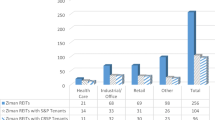Abstract
A key requirement for Real Estate Investment Trusts (REITs) to maintain their corporate tax-exempt status is that 95 percent of income must be distributed as dividents. Receipt of this income imposes a personal tax burden on shareholders. A central tenet of this research is that REIT management is motivated to reduce investors’ personal taxes. This may involve reduction of before-tax income through acquisitions. Market reaction to REIT merger announcements is found to be positive and significant. The evidence developed is more consistent with abnormal returns being related to a tax advantage from acquisitions rather than gaining economies of scale.
Similar content being viewed by others
References
Allen, Paul R., and C. F. Sirmans. 1987. “An Analysis of Gains to Acquiring Firm's Shareholders: The Special Case of REITs.”Journal of Financial Economics 18: 175–84.
Auerbach, Alan J., and David Reishus. 1988. “Taxes and the Merger Decision.” In Chapter 19,Knights, Raiders, and Targets, edited by J.C. Coffee, Jr., Louis Lowenstein, and Susan Rose-Ackerman. New York: Oxford University Press: 300–313.
Brown, Stephen J., and Jerold B. Warner. 1985. “Using Daily Stock Returns: The Case of Event Studies.”Journal of Financial Economics 14: 3–31.
Cowan, Arnold R. 1992. “Nonparametric Event Study Tests.”Review of Quantitative Finance and Accounting 2: 343–58.
Elayan, Fayez A., and Philip J. Young. 1994. “The Value of Control: Evidence from Full and Partial Acquisitions in the Real Estate Industry.”Journal of Real Estate Finance and Economics 8: 167–182.
Ginsburg, M. D. 1983. “Taxing Corporate Acquisitions.”Tax Law Review 38: 177–319.
Ginsburg, M. D. 1988. “Comment.” In Chapter 24,Knights, Raiders and Targets, edited by J. C. Coffee, Jr., Louis Lowenstein, and Susan Rose-Ackerman. New York: Oxford University Press: 366–367.
Haw, In-Mu, Victor S. Pastena, and Steven B. Lilien. 1990. “Market Manifestation of Nonpublic Information Prior to Mergers: The Effect of Capital Structure.”Accounting Review 65: 432–51.
Hayn, Carla. 1989. “Tax Attributes as Determinants of Shareholder Gains in Corporate Acquisitions.”Journal of Financial Economics 23: 121–154.
Jarrell, Gregg, and Annette Poulsen. 1989. “Returns to Acquiring Firms in Tender Offers: Evidence from Three Decades.”Financial Management 18: 12–19.
Jensen, Michael C., Steven Kaplan, and Laura E. Stiglin. 1989. “The Effects of LBO's on Tax Revenues.”Tax Notes, February 6: 727–733.
Jensen, Michael C., and Richard S. Ruback. 1983. “The Market for Corporate Control: The Scientific Evidence.”Journal of Financial Economics 11: 5–50.
Kaplan, Steven. 1989. “Management Buyouts: Evidence on Taxes as a Source Of Value.”Journal of Finance 44: 611–632.
Linn, Scott C., and John J. McConnell. 1983. “An Empirical Investigation of the Impact of Antitakeover Amendments on Common Stock Prices.”Journal of Financial Economics 11: 361–99.
McIntosh, William, Dennis T. Officer, and Jeffrey A. Born. 1989. “The Wealth Effects of Merger Activities: Further Evidence from Real Estate Investment Trusts.”Journal of Real Estate Research 4: 141–155.
Miller, Merton H. 1977. “Debt and Taxes.”Journal of Finance 2: 261–75.
Newport, J. P., Jr. 1988. “Why the IRS Might Love Those LBOs.”Fortune, December 5: 145–152.
Patell, James M. 1976. “Corporate Forecasts of Earnings per Share and Price Behavior: Empirical Tests.”Journal of Accounting Research 14: 246–274.
Poterba, James M. 1988. “Comment on Auerbach and Reishus: The Effects of Taxation on the Merger Decision.” In Chapter 6,Corporate Takeovers: Causes and Consequences, edited by Alan J. Auerbach. Chicago: University of Chicago Press: 183–187.
Schipper, Katherine, and Abbie Smith. 1983. “Effects of Re-Contracting on Shareholder Wealth: The Case of Voluntary Spin-offs.”Journal of Financial Economics 12: 437–468.
Wansley, James W., William R. Lane, and Ho C. Yang. 1987. “Gains to Acquiring Firms in Cash and Securities Transactions.”The Financial Review 22: 403–414.
Author information
Authors and Affiliations
Corresponding author
Rights and permissions
About this article
Cite this article
Li, J., Elayan, F.A. & Meyer, T.O. Acquisitions by Real Estate Investment Trusts as a strategy for minimization of investor tax liability. J Econ Finan 25, 115–134 (2001). https://doi.org/10.1007/BF02759690
Issue Date:
DOI: https://doi.org/10.1007/BF02759690




